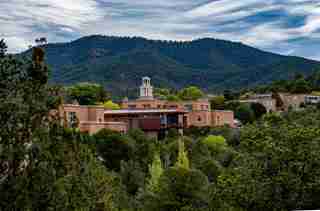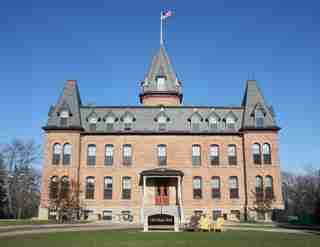With their vast collections of buildings, it’s no wonder that college campuses are architectural gems. In the United States, in particular, college campuses built during the late 19th and early 20th centuries featured beautiful unified styles—oftentimes of the Collegiate Gothic movement, which drew from historic English buildings, but also the Federal, neoclassical, and even Romanesque movements. Campuses also had elegant landscape design, whether well-manicured quads or more natural woodland. While most universities have gone on to include incredible modern builds by 20th-century starchitects (Eero Saarinen's Ingalls Rink at Yale, anyone?), they’ve also worked hard to maintain their visual legacies. We’ve gone across the country to find the most beautiful college campuses in the United States, taking into consideration both architectural legacy and setting. Read on to find out if your alma mater made our list.

University of Hawaii at Manoa: Honolulu, Hawaii
The stately University of Hawaii at Manoa might have beautiful buildings, but it’s its view of Diamond Head that truly stands out.

St. John’s College Santa Fe: Santa Fe, New Mexico
The Santa Fe campus of St. John’s College features low-slung, Southwestern-style architecture. The campus has a number of hiking trails that lead into the surrounding nature.

St. Olaf College: Northfield, Minnesota
Two buildings on St. Olaf College’s 300-acre campus are listed on the National Register of Historic Places, including the 1877 Old Main, shown here.
Brown University: Providence, Rhode Island
Brown University blends well with its surrounding city, almost so much so that you might not even realize you’re on a campus. There’s a mix of Georgian, Victorian, and Gothic buildings here.
Mount Holyoke College: South Hadley, Massachusetts
Mount Holyoke, the first of the historic Seven Sisters consortium of schools, has a bucolic campus lined with redbrick buildings.
University of Vermont: Burlington, Vermont
The redbrick, Federal-style Old Mill, in the distance, is the University of Vermont’s oldest building, erected in 1825 after the original 1802 building burned down.
Swarthmore College: Swarthmore, Pennsylvania
Swarthmore’s campus is centered around the stately Parrish Hall, which was originally the school’s only building and housed everything from dormitories to classrooms to the library.
Trinity College: Hartford, Connecticut
Trinity College’s “Long Walk” comprises several early examples of Collegiate Gothic architecture by British designer William Burges, the first two buildings of which were constructed in 1878. The campus also features a quad by Frederick Law Olmsted and a chapel by the same firm who designed the National Cathedral in Washington, D.C., Frohman, Robb and Little.
United States Naval Academy: Annapolis, Maryland
The incredible Beaux-Arts Bancroft Hall at the United States Naval Academy isn’t a museum nor even an academic building. It’s actually the largest dormitory in the world, with 1,700 rooms spread over 33 acres of floor space.
Lewis & Clark College: Portland, Oregon
The forested campus of Lewis & Clark College makes plenty of sense given its Pacific Northwest location. While historic buildings, like the Frank Manor House, shown here, are beautiful, the newer buildings also impress with their sustainability initiatives.
Belmont University: Nashville, Tennessee
Belmont University, which originally opened as a women’s college, sits on the former Belle Mont estate. The Belmont Mansion, shown here, is a 19,000-square-foot antebellum home on campus that’s open for tours.
Sewanee: The University of the South, Sewanee, Tennessee
The massive 13,000-acre campus of Sewanee mainly features Collegiate Gothic architecture, the highlight of which is the All Saints’ Chapel, shown here.
Wake Forest University: Winston-Salem, North Carolina
Wait Chapel stands out on Wake Forest’s Hearn Plaza. It was the first building constructed on the new campus in Winston-Salem in 1956—the original campus was in Wake Forest, North Carolina.
37: Baylor University: Waco, Texas
Baylor’s campus features primarily Georgian-style buildings, including Pat Neff Hall, shown here, named after the former Texas governor who later became president of the university.
College of the Holy Cross: Worcester, Massachusetts
Noted for its incredible landscape design, the College of the Holy Cross also has a number of historic buildings, including O’Kane Hall, shown here. The area around O’Kane and its neighbor, Fenwick Hall, is listed on the National Register of Historic Places.
Rice University: Houston, Texas
You might mistake Rice University for being in California, thanks to the campus’s Mediterranean Revival style, but it’s actually located in Houston. Shown is the elegant Lovett Hall with Byzantine and Romanesque elements.
Vanderbilt University, Nashville, Tennessee
Vanderbilt’s campus is designated a national arboretum, with nearly 200 species of trees and shrubs. Dispersed among the greenery are a number of beautiful buildings, like Kirkland Hall, shown here, which replaced the university’s main building after a fire in 1905.
Furman University: Greenville, South Carolina
Furman University’s signature structure is its iconic bell tower. It’s actually a faithful re-creation: The original, built in 1854, was left behind on Furman’s old campus as it was too fragile to move when the university relocated to Greenville in the mid-20th century.
Indiana University Bloomington: Bloomington, Indiana
Many of Indiana University’s buildings feature the local Indiana limestone, used in a variety of styles from Gothic to Romanesque Revival.
Washington University in St. Louis: St. Louis, Missouri
When WashU decided to move its campus from downtown St. Louis to more spacious grounds within city limits, it hosted a design competition for the new campus. Firm Cope & Stewardson won with a project that drew inspiration from Oxford and Cambridge in the U.K.
Northwestern University: Evanston, Illinois
Northwestern’s location on the shore of Lake Michigan wins the university points from us, as does its range of architecture spanning from Collegiate Gothic to Brutalist.
University of Mississippi: Oxford, Mississippi
The Lyceum Building at Ole Miss was the first academic building established on campus, built in 1848 by architect William Nichols.
University of North Carolina at Chapel Hill: Chapel Hill, North Carolina
Designed by Arthur Cleveland Nash and William Kendall of McKim, Mead, and White in the late 1920s, UNC’s Louis Round Wilson Library is an example of Beaux-Arts architecture.
University of Washington: Seattle, Washington
The Liberal Arts Quadrangle at the University of Washington is lined with beautiful Collegiate Gothic buildings, but the showstoppers are the 30 Yoshino cherry trees that blossom each spring.
Southern Methodist University: Dallas, Texas
Dallas Hall was Southern Methodist University's first building, designed by Shepley, Rutan and Coolidge in the style of the University of Virginia’s Rotunda.
Columbia University: New York, New York
Renowned architecture firm McKim, Mead & White designed a number of Columbia’s Beaux-Arts buildings, including Low Memorial Library, shown here, which now houses administrative offices.
Salve Regina University: Newport, Rhode Island
Located in posh Newport, Salve Regina University comprises a number of Gilded Age mansions, including Ochre Court, shown here, which is the second largest estate in town after the Breakers.
University of Pennsylvania: Philadelphia, Pennsylvania
Nestled into the heart of Philadelphia, Penn might not have the rolling hills of other college campuses, but it does have plenty of Collegiate Gothic architecture. Many of the school’s original buildings were designed by Cope & Stewardson, a firm that worked on a number of university projects, including ones at Princeton and Washington University in St. Louis.
University of Missouri: Columbia, Missouri
The heart of Mizzou is the Francis Quadrangle, home to the six columns that are the only remaining part of the original Academic Hall, which burned down in 1892.
Rhodes College: Memphis, Tennessee
Despite being located in the middle of a city, Rhodes College has a beautiful wooded campus with uniformly Collegiate Gothic buildings made of Arkansas sandstone, Vermont slate, and Indiana limestone.
University of California, Berkeley: Berkeley, California
The campus of UC Berkeley was actually designed via a competition; the winner was French architect Émile Bénard, who assigned John Galen Howard to oversee the project. The result was a Beaux-Arts campus.
Cornell University: Ithaca, New York
Cornell’s hillside location above Cayuga Lake among scenic gorges is incredibly picturesque, and its diverse architecture impresses as well. The older buildings on campus display ornate Collegiate Gothic, neoclassical, and Victorian styles, while modernism abounds in newer areas.
University of Notre Dame: Notre Dame, Indiana
When the original University of Notre Dame Main Building burned down in 1879, it was replaced with this gold-domed structure, which has become a symbol of the school.
University of Chicago: Chicago, Illinois
The University of Chicago’s campus straddles the Midway Plaisance, a park created for the 1893 World’s Columbian Exposition, and its oldest buildings on either side of the park were inspired by those at Oxford University.
Vassar College: Poughkeepsie, New York
Vassar’s 1,000 acres are filled with more than 100 buildings in a variety of architectural styles, from the Gothic Thompson Memorial Library (shown here) to Marcel Breuer's Ferry House to César Pelli’s Lehman Loeb Art Center.
University of Colorado Boulder: Boulder, Colorado
While some of the oldest buildings at the University of Colorado Boulder feature the traditional Collegiate Gothic style, the school hired architect Charles Klauder to design an entirely new architectural style for the campus, called Tuscan Vernacular Revival (or, colloquially, University of Colorado Style), featuring sandstone buildings with red roofs.
Duke University: Durham, North Carolina
There are 254 buildings on Duke’s campus, and none is more impressive than the Duke Chapel, a beacon of Collegiate Gothic architecture.
Georgetown University: Washington, D.C.
Georgetown’s Healy Hall was built by Paul J. Pelz and John L. Smithmeyer, who were known for designing the Library of Congress. The National Historic Landmark features both Gothic Revival and Romanesque details.
Harvard University: Cambridge, Massachusetts
The oldest college in the United States, Harvard has an architecturally diverse campus, from the Georgian redbrick buildings surrounding Harvard Yard to Le Corbusier’s only work in the country, the Carpenter Center for the Visual Arts.
University of Virginia: Charlottesville, Virginia
Thomas Jefferson designed the Academical Village of the University of Virginia in what is considered one of the most important architectural projects in U.S. history. The neoclassical campus, along with Jefferson’s home, Monticello, are a UNESCO World Heritage Site.
University of California, Los Angeles: Los Angeles, California
Though the campus now covers more than 400 acres, UCLA started with just four academic buildings, including Royce Hall, shown here. The four Romanesque Revival structures were conceived by local architects Allison & Allison.
Dartmouth College: Hanover, New Hampshire
The Baker-Berry Library at Dartmouth College features a historic building inspired by Independence Hall in Philadelphia with a modern addition by Robert Venturi.
William & Mary: Williamsburg, Virginia
Appropriately colonial in style—William & Mary and its campus was founded well before the establishment of the United States, in 1693—the Wren Building by famous English architect Sir Christopher Wren is the oldest college building in the country, completed in 1700.
Flagler College: St. Augustine, Florida
Flagler College acquired the former Ponce de Leon Hotel, a stunning Spanish Renaissance masterpiece, in 1968.
Colgate University: Hamilton, New York
Set in the bucolic village of Hamilton, Colgate University has a serene countryside campus. Its most famous structure is the Colgate Memorial Chapel, built in 1918.
5: Kenyon College: Gambier, Ohio
The historic stone buildings of Kenyon College are a marvel, lending a very collegiate atmosphere to the small liberal arts school.
Stanford University: Stanford, California
One of the most beautiful areas on Stanford’s large campus is the Main Quadrangle, which takes on a California Mission style. Frederick Law Olmsted and Shepley, Rutan and Coolidge (associates of the late Henry Hobson Richardson) worked on the design.
Berry College: Mount Berry, Georgia
When it comes to a beautiful setting, Berry college can’t be beat: Its campus has more than 27,000 acres of forests and fields, and there’s even a mountain. And it has gorgeous English Gothic architecture to boot.
Princeton University: Princeton, New Jersey
Princeton University has a campus that’s the epitome of Collegiate Gothic architecture, though it also has modern buildings, including Spelman Hall by I.M. Pei, Lewis Library by Frank Gehry, and the Carl Icahn Laboratory by Rafael Viñoly.
Yale University: New Haven, Connecticut
Yale has one of the most impressive collections of architecture in the country. Though the majority of the campus is done in the Collegiate Gothic style, there are some modernist gems, including Eero Saarinen’s Ingalls Rink; Skidmore, Owings and Merrell’s Beinecke Rare Book and Manuscript Library; Paul Rudolph’s Art & Architecture Building; and Louis Kahn’s Yale Art Gallery and Center for British Art.
